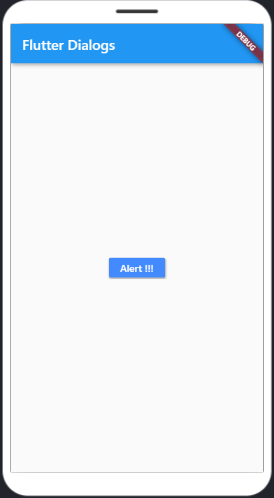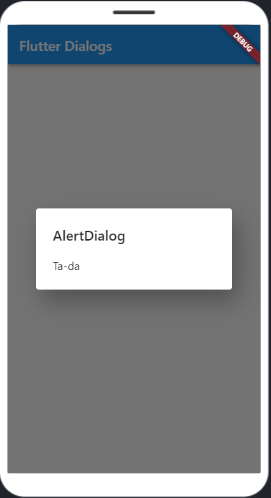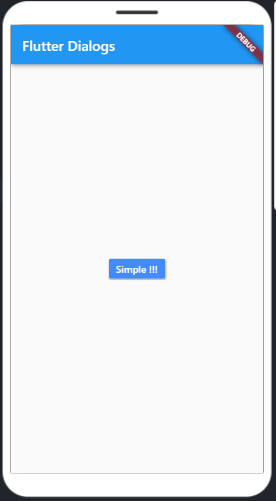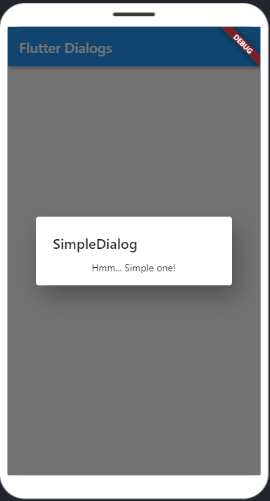[Flutter] Form, Alert에 사용할 수 있는 플러터 컴포넌트
플러터의 위젯들을 많이 살펴봤는데요. 이 글에서는 알람과 다이얼로그, 폼과 같이 입력할 수 있는 컴포넌트 위젯에 대해 알아보고자 합니다.
Dialogs, Alerts, Panels
먼저 다이얼로그와 Alert부터 살펴보겠습니다.
import 'package:flutter/material.dart';
void main() {
runApp(MyApp());
}
class MyApp extends StatelessWidget {
@override
Widget build(BuildContext context) {
return MaterialApp(
title: "MaterialApp",
home: TestDialog(),
);
}
}
class TestDialog extends StatelessWidget {
@override
Widget build(BuildContext context) {
return Scaffold(
appBar: AppBar(title: Text("Flutter Dialogs")),
body: Container(
child: Center(
),
),
);
}
}
여기서부터 시작해봅시다. context를 가져오기 위해 MyApp에서 분리했습니다.
AlertDialog
사용자에게 경고나 알림을 주기 위해 사용합니다.
AlertDialog는 이러한 설정이 가능합니다.
const AlertDialog({
Key? key,
this.title,
this.titlePadding,
this.titleTextStyle,
this.content,
this.contentPadding = const EdgeInsets.fromLTRB(24.0, 20.0, 24.0, 24.0),
this.contentTextStyle,
this.actions,
this.actionsPadding = EdgeInsets.zero,
this.actionsAlignment,
this.actionsOverflowDirection,
this.actionsOverflowButtonSpacing,
this.buttonPadding,
this.backgroundColor,
this.elevation,
this.semanticLabel,
this.insetPadding = _defaultInsetPadding,
this.clipBehavior = Clip.none,
this.shape,
this.alignment,
this.scrollable = false,
})
사용 예시입니다.
import 'package:flutter/material.dart';
void main() {
runApp(MyApp());
}
class MyApp extends StatelessWidget {
@override
Widget build(BuildContext context) {
return MaterialApp(
title: "MaterialApp",
home: TestDialog(),
);
}
}
class TestDialog extends StatelessWidget {
@override
Widget build(BuildContext context) {
return Scaffold(
appBar: AppBar(title: Text("Flutter Dialogs")),
body: Container(
child: Center(
child: RaisedButton(
color: Colors.blueAccent,
textColor: Colors.white,
onPressed: () {
testAlert(context);
},
child: Text("Alert !!!"),
),
),
),
);
}
void testAlert(BuildContext context) {
var alert = AlertDialog(
title: Text("AlertDialog"),
content: Text("Ta-da"),
);
showDialog(
context: context,
builder: (BuildContext context) {
return alert;
});
}
}


SimpleDialog
AlertDialog와 유사하지만, 이름 그대로 매개변수가 좀더 적고 간단합니다.
AlertDialog에는 content를 작성했는데, SimpleDialog에서는 내용을 적을 때 children에 적어주어야 합니다.
const SimpleDialog({
Key? key,
this.title,
this.titlePadding = const EdgeInsets.fromLTRB(24.0, 24.0, 24.0, 0.0),
this.titleTextStyle,
this.children,
this.contentPadding = const EdgeInsets.fromLTRB(0.0, 12.0, 0.0, 16.0),
this.backgroundColor,
this.elevation,
this.semanticLabel,
this.insetPadding = _defaultInsetPadding,
this.clipBehavior = Clip.none,
this.shape,
this.alignment,
})
코드 작성은 AlertDialog와 크게 다르지 않습니다.
AlertDialog의 testAlert 부분에서 SimpleDialog로 바꿔줍니다. content 대신 children을 작성합니다.
void testAlert(BuildContext context) {
var alert = SimpleDialog(
title: Text("AlertDialog"),
children: [
Center(
child: Text('Hmm... Simple one!'),
)
],
);
showDialog(
context: context,
builder: (BuildContext context) {
return alert;
});
}


SnackBar
SnackBar는 팝업 메시지를 일시적으로 표시할 수 있는 위젯입니다. 보통 앱 하단에 띄우는 경우가 많습니다.
예를 들자면 장바구니 추가 알림 같은 (경고보다는 중요도가 떨어지는) 알람을 사용할 때 쓰는 것 같습니다.
SnackBar는 이런 설정이 가능합니다.
const SnackBar({
Key? key,
required this.content,
this.backgroundColor,
this.elevation,
this.margin,
this.padding,
this.width,
this.shape,
this.behavior,
this.action,
this.duration = _snackBarDisplayDuration,
this.animation,
this.onVisible,
this.dismissDirection = DismissDirection.down,
})
SnackBar를 사용하기 위해 위젯을 변경했습니다.
import 'package:flutter/material.dart';
void main() {
runApp(MyApp());
}
class MyApp extends StatelessWidget {
@override
Widget build(BuildContext context) {
return MaterialApp(
title: "MaterialApp",
// SnackBarPage로 설정
home: SnackBarPage(),
);
}
}
// SnackBarPage class 생성
class SnackBarPage extends StatelessWidget {
const SnackBarPage({Key? key}) : super(key: key);
@override
Widget build(BuildContext context) {
return Scaffold(
appBar: AppBar(
title: Text('Flutter SnackBar'),
centerTitle: true
),
body: Center(
child: ElevatedButton(
onPressed: () {
final snackBar = SnackBar(
content: const Text('Hi, I am a SnackBar!'),
backgroundColor: (Colors.black12),
action: SnackBarAction(
label: 'dismiss',
onPressed: () {},
),
);
ScaffoldMessenger.of(context).showSnackBar(snackBar);
},
child: const Text(
'Click to Display a SnackBar',
),
),
));
}
}
ElevatedButton의 onPressed에 SnackBar를 호출하도록 작성했습니다. 아래와 같은 결과가 나옵니다.
ExpansionPanel
ExpansionPanel은 저에게는 아코디언 같은 이름으로 좀더 익숙한 위젯입니다. 펼쳐보기 + 접기가 가능합니다.
ExpansionPanelList와 함께 사용합니다. state가 필요해 ExpansionPanelDemo를 StatefulWidget으로 작성했습니다.
import 'package:flutter/material.dart';
void main() {
runApp(MyApp());
}
class MyApp extends StatelessWidget {
@override
Widget build(BuildContext context) {
return MaterialApp(
title: 'Flutter Demo',
home: ExpansionPanelDemo(),
);
}
}
class ExpansionPanelDemo extends StatefulWidget {
ExpansionPanelDemo({Key? key}) : super(key: key);
@override
_ExpansionPanelDemoState createState() => _ExpansionPanelDemoState();
}
class _ExpansionPanelDemoState extends State<ExpansionPanelDemo> {
List<Item> _items = generateItems(8);
@override
Widget build(BuildContext context) {
return Scaffold(
appBar: AppBar(
title: Text('Flutter ExpansionPanel'),
centerTitle: true
),
// 펼쳤을 때 화면을 넘어갈 수 있으므로 ScrollView로 처리합니다.
body: SingleChildScrollView(
child: Container(
padding: EdgeInsets.only(top: 80),
child: _buildPanel(),
),
),
);
}
Widget _buildPanel() {
return ExpansionPanelList(
expansionCallback: (int index, bool isExpanded) {
setState(() {
_items[index].isExpanded = !isExpanded;
});
},
children: _items.map<ExpansionPanel>((Item item) {
return ExpansionPanel(
headerBuilder: (BuildContext context, bool isExpanded) {
return ListTile(
title: Text(item.headerValue),
);
},
body: ListTile(
title: Text(item.expandedValue),
),
isExpanded: item.isExpanded,
);
}).toList(),
);
}
}
// ExpansionPanel state 정보를 저장합니다.
class Item {
Item({
required this.expandedValue,
required this.headerValue,
this.isExpanded = false,
});
String expandedValue;
String headerValue;
bool isExpanded;
}
List<Item> generateItems(int numberOfItems) {
return List.generate(numberOfItems, (int index) {
return Item(
headerValue: 'Item ${index + 1}',
expandedValue: 'Item ${index + 1} Detail',
);
});
}
BottomSheet
하단에서 올라오는 시트 위젯입니다.
import 'package:flutter/material.dart';
void main() => runApp(new MyApp());
class MyApp extends StatelessWidget {
@override
Widget build(BuildContext context) {
return new MaterialApp(
title: 'Flutter Demo',
theme: new ThemeData(
primarySwatch: Colors.blue,
),
home: new BottomSheetPage(),
);
}
}
class BottomSheetPage extends StatefulWidget {
BottomSheetPage({Key? key}) : super(key: key);
@override
_BottomSheetPageState createState() => new _BottomSheetPageState();
}
class _BottomSheetPageState extends State<BottomSheetPage> {
@override
Widget build(BuildContext context) {
return new Scaffold(
appBar: new AppBar(
title: new Text('Flutter BottomSheet'),
),
floatingActionButton: new FloatingActionButton(
onPressed: () {
_settingModalBottomSheet(context);
},
child: new Icon(Icons.add),
),
);
}
}
void _settingModalBottomSheet(context) {
showModalBottomSheet(
context: context,
builder: (BuildContext bc) {
return Container(
child: new Wrap(
children: <Widget>[
new ListTile(
leading: new Icon(Icons.music_note),
title: new Text('Music'),
onTap: () => {}),
new ListTile(
leading: new Icon(Icons.videocam),
title: new Text('Video'),
onTap: () => {},
),
],
),
);
});
}
Input & Selections
다음은 흔히 Form을 만들 때 사용할 수 있는 컴포넌트 위젯들을 살펴보겠습니다.
import 'package:flutter/material.dart';
void main() {
runApp(MaterialApp(
home: InputSelectionPage(),
));
}
class InputSelectionPage extends StatefulWidget {
@override
_InputSelectionPageState createState() => _InputSelectionPageState();
}
class _InputSelectionPageState extends State<InputSelectionPage> {
@override
Widget build(BuildContext context) {
return MaterialApp(
home: Scaffold(
appBar: AppBar(
title: Text('Flutter Input & Selection'),
),
body: Column(
children: <Widget>[
],
)),
);
}
}
여기서부터 시작해보겠습니다. 기본 코드에 계속 input 요소들을 추가 해볼겁니다.
Checkbox
웹에서도 볼 수 있는 checkbox입니다. Input & Selection 부분은 웹과 동일한 부분이 많아 익숙하게 느껴졌습니다.
Checkbox는 bool 타입으로 작동합니다. 체크되었냐 or 체크되지 않았냐 두 가지의 상태입니다.
class _InputSelectionPageState extends State<InputSelectionPage> {
// state 설정
bool? valuefirst = false;
bool? valuesecond = false;
@override
Widget build(BuildContext context) {
return MaterialApp(
home: Scaffold(
appBar: AppBar(
title: Text('Flutter Input & Selection'),
),
body: Column(
children: <Widget>[
Row(
children: <Widget>[
SizedBox(
width: 10,
),
Text(
'Checkbox ',
style: TextStyle(fontSize: 17.0),
),
Checkbox(
checkColor: Colors.greenAccent,
activeColor: Colors.red,
value: this.valuefirst,
onChanged: (bool? value) {
setState(() {
this.valuefirst = value;
});
},
),
Checkbox(
value: this.valuesecond,
onChanged: (bool? value) {
setState(() {
this.valuesecond = value;
});
},
),
],
),
],
)),
);
}
}
Date & Time Pickers
날짜와 시간 선택이 가능한 위젯입니다. showDatePicker를 사용합니다.
먼저 날짜를 선택했을 때 바뀔 state를 위해 selectedDate를 하나 선언 할당합니다.
자바스크립트에서는 promise에 해당하는 Future가 있습니다. 비동기처리로 selectedDate를 컨트롤합니다.
class _InputSelectionPageState extends State<InputSelectionPage> {
bool? valuefirst = false;
bool? valuesecond = false;
// DateTime 타입으로 selectedDate를 설정합니다.
DateTime selectedDate = DateTime.now();
// 비동기 처리
Future<void> _selectDate(BuildContext context) async {
final DateTime? picked = await showDatePicker(
context: context,
initialDate: selectedDate, // 첫 세팅을 selecteDate로
firstDate: DateTime(2015, 8), // 2015년도 8월부터 선택 가능
lastDate: DateTime(2025)); // 2025년도까지 선택 가능
// picked가 null이 아니고 첫 값이랑 똑같지 않으면 selectedDate를 picked로 치환.
if (picked != null && picked != selectedDate) {
setState(() {
selectedDate = picked;
});
}
}
//...
}
Column의 children 속에 Row를 하나 더 작성해 picker를 열고, 선택된 날짜를 보여주도록 작성합니다.
Row(
children: <Widget>[
SizedBox(
width: 10,
),
Text(
'Date picker ',
style: TextStyle(fontSize: 17.0),
),
SizedBox(
height: 20.0,
),
RaisedButton(
// 비동기 처리한 _selectDate 호출
onPressed: () => _selectDate(context),
child: Text('Select date'),
),
SizedBox(
width: 20.0,
),
Text("${selectedDate.toLocal()}".split(' ')[0]),
],
),
Radio
여러 선택지 중 하나를 고를 수 있게 하는 위젯입니다.
성별로 선택지를 만들어보겠습니다.
먼저 enum Gender 를 클래스 밖에 만들어줍니다.
enum Gender { female, male }
그리고 state를 만들어줍니다.
class _InputSelectionPageState extends State<InputSelectionPage> {
//...
// 기본값을 female로 세팅
Gender? _gender = Gender.female;
//...
}
마지막으로 Row를 하나 더 추가합니다.
Row(
children: <Widget>[
SizedBox(
width: 10,
),
Text(
'Radio ',
style: TextStyle(fontSize: 17.0),
),
SizedBox(
width: 10,
),
Text(
'Female ',
style: TextStyle(fontSize: 17.0),
),
Radio<Gender>(
value: Gender.female,
groupValue: _gender,
onChanged: (Gender? value) {
setState(() {
_gender = value;
});
},
),
Text(
'Male ',
style: TextStyle(fontSize: 17.0),
),
Radio<Gender>(
value: Gender.male,
groupValue: _gender,
onChanged: (Gender? value) {
setState(() {
_gender = value;
});
},
)
],
),
Slider
보통 음량 조절 할때 많이 볼 수 있는 Slider입니다.
state를 하나 만들어줍니다.
Slider의 min값은 0이고, max 값은 1입니다.
class _InputSelectionPageState extends State<InputSelectionPage> {
//...
// 기본값을 0.0으로 세팅
double _volumn = 0.0;
//...
}
그리고 Row를 하나 더 만듭니다.
Row(
children: <Widget>[
SizedBox(
width: 10,
),
Text(
'Slider ',
style: TextStyle(fontSize: 17.0),
),
Slider(
value: _volumn,
onChanged: (value) {
setState(() {
_volumn = value;
});
},
),
Text("${(_volumn * 100).toStringAsFixed(2)}"),
],
),
0부터 1까지의 값이 아닌, 1부터 100까지를 보여주고 싶어 toStringAsFixed를 이용했습니다.
Switch
저는 흔히 토글이라고 불러온 버튼입니다. 참/거짓 2가지의 값만 가질 수 있습니다.
class _InputSelectionPageState extends State<InputSelectionPage> {
//...
// 기본값을 false로 세팅
bool isSwitched = false;
//...
}
Row를 또 작성해봅시다.
Row(
children: <Widget>[
SizedBox(width: 10),
Text(
'Switch ',
style: TextStyle(fontSize: 17.0),
),
Switch(
value: isSwitched,
onChanged: (value) {
setState(() {
isSwitched = value;
});
},
activeTrackColor: Colors.lightBlueAccent,
activeColor: Colors.blue,
),
],
)
TextField
html에서 볼 수 있는 <input type="text">와 같은 문자 입력 위젯입니다.
문자를 입력할 때마다 바뀌도록, state와 TextEditingController를 추가합니다.
class _InputSelectionPageState extends State<InputSelectionPage> {
//...
TextEditingController nameController = TextEditingController();
String _anyText = '';
//...
}
TextField를 사용할 때에는 너비가 지정된 상태로 사용해야 합니다.
Row 밑에 그냥 넣었다가 에러가 발생했습니다.
따라서 우리는 SizedBox에다가 TextField를 넣어줍시다.
Row(
children: <Widget>[
SizedBox(width: 10),
Text(
'TextField ',
style: TextStyle(fontSize: 17.0),
),
SizedBox(
width: 150,
child: TextField(
controller: nameController,
onChanged: (text) {
setState(() {
_anyText = text;
});
},
)),
Text("${_anyText}"),
],
)
여기까지 완료하면 이렇게 만들어집니다.
전체 코드는 이렇습니다.
import 'package:flutter/material.dart';
void main() {
runApp(MaterialApp(
home: InputSelectionPage(),
));
}
class InputSelectionPage extends StatefulWidget {
@override
_InputSelectionPageState createState() => _InputSelectionPageState();
}
enum Gender { female, male }
class _InputSelectionPageState extends State<InputSelectionPage> {
bool? valuefirst = false;
bool? valuesecond = false;
DateTime selectedDate = DateTime.now();
Future<void> _selectDate(BuildContext context) async {
final DateTime? picked = await showDatePicker(
context: context,
initialDate: selectedDate,
firstDate: DateTime(2015, 8),
lastDate: DateTime(2101));
if (picked != null && picked != selectedDate) {
setState(() {
selectedDate = picked;
});
}
}
Gender? _gender = Gender.female;
double _volumn = 0.0;
bool isSwitched = false;
TextEditingController nameController = TextEditingController();
String _anyText = '';
@override
Widget build(BuildContext context) {
return MaterialApp(
home: Scaffold(
appBar: AppBar(
title: Text('Flutter Input & Selection'),
),
body: Column(
children: <Widget>[
SizedBox(
height: 30,
),
Row(
children: <Widget>[
SizedBox(
width: 10,
),
Text(
'Checkbox ',
style: TextStyle(fontSize: 17.0),
),
Checkbox(
checkColor: Colors.greenAccent,
activeColor: Colors.red,
value: this.valuefirst,
onChanged: (bool? value) {
setState(() {
this.valuefirst = value;
});
},
),
Checkbox(
value: this.valuesecond,
onChanged: (bool? value) {
setState(() {
this.valuesecond = value;
});
},
),
],
),
Row(
children: <Widget>[
SizedBox(
width: 10,
),
Text(
'Date picker ',
style: TextStyle(fontSize: 17.0),
),
SizedBox(
height: 20.0,
),
RaisedButton(
onPressed: () => _selectDate(context),
child: Text('Select date'),
),
SizedBox(
width: 20.0,
),
Text("${selectedDate.toLocal()}".split(' ')[0]),
],
),
Row(
children: <Widget>[
SizedBox(
width: 10,
),
Text(
'Radio ',
style: TextStyle(fontSize: 17.0),
),
SizedBox(
width: 10,
),
Text(
'Female ',
style: TextStyle(fontSize: 17.0),
),
Radio<Gender>(
value: Gender.female,
groupValue: _gender,
onChanged: (Gender? value) {
setState(() {
_gender = value;
});
},
),
Text(
'Male ',
style: TextStyle(fontSize: 17.0),
),
Radio<Gender>(
value: Gender.male,
groupValue: _gender,
onChanged: (Gender? value) {
setState(() {
_gender = value;
});
},
)
],
),
Row(
children: <Widget>[
SizedBox(
width: 10,
),
Text(
'Slider ',
style: TextStyle(fontSize: 17.0),
),
Slider(
value: _volumn,
onChanged: (value) {
setState(() {
_volumn = value;
});
},
),
Text("${(_volumn * 100).toStringAsFixed(2)}"),
],
),
Row(
children: <Widget>[
SizedBox(width: 10),
Text(
'Switch ',
style: TextStyle(fontSize: 17.0),
),
Switch(
value: isSwitched,
onChanged: (value) {
setState(() {
isSwitched = value;
});
},
activeTrackColor: Colors.lightBlueAccent,
activeColor: Colors.blue,
),
],
),
Row(
children: <Widget>[
SizedBox(width: 10),
Text(
'TextField ',
style: TextStyle(fontSize: 17.0),
),
SizedBox(
width: 150,
child: TextField(
controller: nameController,
onChanged: (text) {
setState(() {
_anyText = text;
});
},
)),
Text("${_anyText}"),
],
)
],
)),
);
}
}
◾ [Flutter] 다양한 버튼 사용하기 👈 이전 글 보기
◾ [Flutter] CircularProgressIndicator와 Chip 사용해보기 👈 다음 글 보기